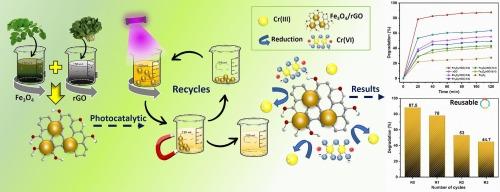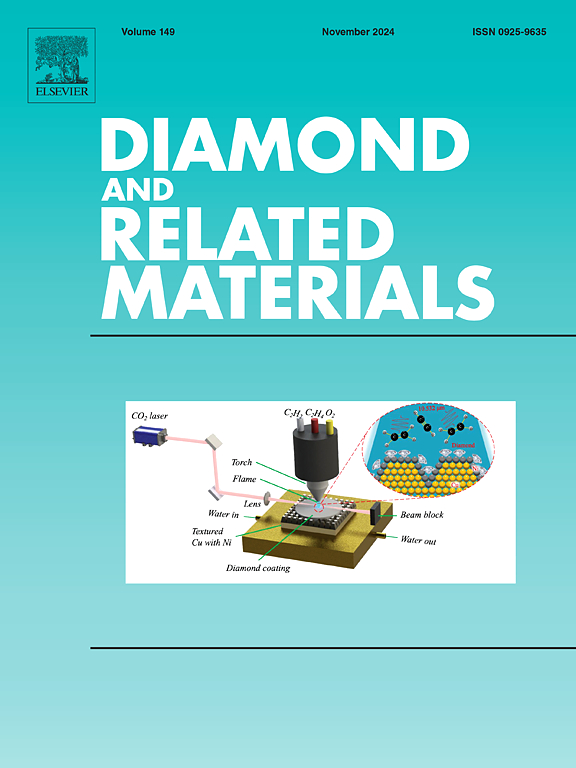通过绿色方法合成的磁性可分离、可重复使用的 Fe3O4/rGO 光催化剂在重金属离子还原中的应用
IF 4.3
3区 材料科学
Q2 MATERIALS SCIENCE, COATINGS & FILMS
引用次数: 0
摘要
出于对水的需求和人类健康的考虑,减少水中的重金属离子至关重要。光催化还原重金属离子的探索开辟了一条新路。此外,纳米粒子的绿色合成方法因其环保、低成本和无毒性而备受关注。本研究利用树叶提取物合成了 Fe3O4/rGO 纳米复合材料,并确定了 Fe3O4/rGO 纳米复合材料中 rGO 的浓度对将六价铬(Cr(VI))降解为环保型三价铬(Cr(III))的影响。Fe3O4纳米粒子是利用油辣木叶提取物作为天然还原剂和俘获剂,通过简单的共沉淀法制备的,而rGO则是利用马齿苋叶提取物从GO中还原出来的。Fe3O4/rGO 纳米复合材料呈现立方反尖晶石结构,晶粒大小约为 7.4 纳米。Fe3O4/rGO 纳米复合材料具有不完美的球形形态,粒径为 10.7 纳米。FeO和CC官能团的存在证实了纳米复合材料中含有Fe3O4和rGO,这也得到了元素组成数据的支持。纳米复合材料具有超顺磁性,饱和磁化率高,磁响应强。在紫外线照射下,120 分钟内 Cr(VI) 的光催化降解效率达到 87.5%。纳米复合材料的磁性可分离性使其易于分离和循环使用,该纳米复合材料已成功重复使用三次,且降解效率很高。Fe3O4/rGO 纳米复合材料有望成为一种低成本、可重复使用的绿色光催化剂,用于环境修复。本文章由计算机程序翻译,如有差异,请以英文原文为准。

Magnetically separable and reusable Fe3O4/rGO photocatalyst synthesized through green approach for heavy metal ion reduction application
The reduction of heavy metal ions in water is essential due to the water demand and human health. The exploration of photocatalytic for heavy metal ions reduction paves a new way. Additionally, the green route synthesis of nanoparticles has gained attention due to environmentally friendly, low-cost, and non-toxic methods. This study investigated the synthesis of Fe3O4/rGO nanocomposites utilizing leaves extract and to determine the effect of rGO concentration in Fe3O4/rGO nanocomposites on the degradation of hexavalent chromium (Cr(VI)) to be an environmentally friendly trivalent chromium (Cr(III)). Fe3O4 nanoparticles were prepared by simple co-precipitation method using Moringa oleifera leaves extract as a natural reducing and captivating agent, while rGO was reduced from GO using Amaranthus viridis leaves extract. Fe3O4/rGO nanocomposites exhibit a cubic inverse spinel structure with a crystallite size of approximately 7.4 nm. Fe3O4/rGO nanocomposite have imperfect spherical morphology with a particle size of 10.7 nm. The presence of Fe![]() O and C
O and C![]() C functional groups confirm the presence of Fe3O4 and rGO in the nanocomposite which also support by the element composition data. The nanocomposites have superparamagnetic behavior with high saturation magnetization that show strong magnetic response. Under UV irradiation, the photocatalytic process of Cr(VI) achieved a degradation efficiency of 87.5 % for 120 min. The magnetically separable capability allows for easy separation and recycle of the nanocomposites, which was successfully reused three times with high degradation efficiency. The Fe3O4/rGO nanocomposites demonstrates potential as a low-cost and green reusable photocatalyst for environmental remediation.
C functional groups confirm the presence of Fe3O4 and rGO in the nanocomposite which also support by the element composition data. The nanocomposites have superparamagnetic behavior with high saturation magnetization that show strong magnetic response. Under UV irradiation, the photocatalytic process of Cr(VI) achieved a degradation efficiency of 87.5 % for 120 min. The magnetically separable capability allows for easy separation and recycle of the nanocomposites, which was successfully reused three times with high degradation efficiency. The Fe3O4/rGO nanocomposites demonstrates potential as a low-cost and green reusable photocatalyst for environmental remediation.
求助全文
通过发布文献求助,成功后即可免费获取论文全文。
去求助
来源期刊

Diamond and Related Materials
工程技术-材料科学:综合
CiteScore
6.00
自引率
14.60%
发文量
702
审稿时长
2.1 months
期刊介绍:
DRM is a leading international journal that publishes new fundamental and applied research on all forms of diamond, the integration of diamond with other advanced materials and development of technologies exploiting diamond. The synthesis, characterization and processing of single crystal diamond, polycrystalline films, nanodiamond powders and heterostructures with other advanced materials are encouraged topics for technical and review articles. In addition to diamond, the journal publishes manuscripts on the synthesis, characterization and application of other related materials including diamond-like carbons, carbon nanotubes, graphene, and boron and carbon nitrides. Articles are sought on the chemical functionalization of diamond and related materials as well as their use in electrochemistry, energy storage and conversion, chemical and biological sensing, imaging, thermal management, photonic and quantum applications, electron emission and electronic devices.
The International Conference on Diamond and Carbon Materials has evolved into the largest and most well attended forum in the field of diamond, providing a forum to showcase the latest results in the science and technology of diamond and other carbon materials such as carbon nanotubes, graphene, and diamond-like carbon. Run annually in association with Diamond and Related Materials the conference provides junior and established researchers the opportunity to exchange the latest results ranging from fundamental physical and chemical concepts to applied research focusing on the next generation carbon-based devices.
 求助内容:
求助内容: 应助结果提醒方式:
应助结果提醒方式:


